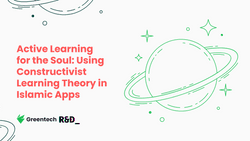Active Learning for the Soul: Using Constructivist Learning Theory in Islamic Apps

Published: 27 April 2025
Author: Dr Riasat Islam
بسم الله الرحمن الرحيم
As Muslims strive to connect with the Qur’an, Hadith, and Seerah, many of us feel the desire to understand—not just read. At Greentech Apps Foundation (GTAF), our mission has always been to help Muslims come closer to Allah ﷻ through meaningful engagement with Islamic knowledge. But understanding doesn’t happen by passive reading alone.
To truly understand Islam, learners need to actively construct knowledge through personal exploration, reflection, and application. This is why we are integrating Constructivist Learning Theory into the design of our apps and educational experiences.
What is Constructivist Learning?
Constructivist learning is a theory that argues that learners build (or “construct”) new knowledge based on their existing knowledge [1]. Learning is an active, contextualized process where learners engage with material, ask questions, make connections, and apply what they’ve learned.
This theory is at the heart of popular apps like Duolingo, which doesn’t just present vocabulary but helps learners internalize and apply it through interactivity, repetition, and structured scaffolding.
At GTAF, we aim to do the same—but with the Qur’an, Hadith, and Seerah—guiding users toward deep, holistic, and applied understanding of Islam.
Applying the OPAR Method in Islamic Learning
One powerful method for designing constructivist learning experiences is OPAR [2]:
- Orientate – Introduce learners to what they are about to study
- Present – Present the core material in a structured, meaningful way
- Apply – Let learners engage and apply the material through interaction
- Review – Help learners consolidate their understanding through reflection and spaced repetition
We are working to integrate the OPAR model across our core apps—Qur’an, Hadith, Seerah, and Sadiq—to create interconnected learning experiences rooted in Islamic tradition.
Example: Understanding Surah Al-Asr Through OPAR
1. Orientate
The user is given an introduction:
- When was Surah Al-Asr revealed?
- What is its theme?
- Why is it important to understand?
💡 “This surah was revealed in the early Makkan period, a time when the Muslims were a small, persecuted group. Its message offered clarity, urgency, and hope.”
2. Present
Now the app presents the content in an integrated way:
- Qur’an: The text of the surah, with word-by-word meanings and audio recitation
- Tafsir: Explanation from trusted sources, simplifying key concepts
- Hadith: Related ahadith about the value of time, community, enjoining truth and patience
- Seerah: Context of how the early Muslims, such as the Sahabah, used this surah in their daily lives—like how they would recite it to one another before parting
3. Apply
The learner is prompted to reflect and apply:
- What actions can I take today to avoid being “in loss”?
- How can I practice sabr (patience) and truth in my relationships?
- How can I remind my friends or family of this surah’s wisdom?
🌱 “Create a weekly habit to check on a friend and remind each other of Surah Al-Asr. Reflect on how you spent your time this week and journal your progress.”
The app could also include:
- Short quizzes
- Role-play scenarios
- “Journal reflections” to track personal insights and goals
4. Review
To help long-term retention, we use spaced repetition:
- Weekly quiz reminders to test key lessons
- A “Reflection Rewind” that reminds users what they learned weeks ago
- Flashcards for key ayahs, words, and hadith
- Notifications during relevant moments of the day (e.g., a Friday reminder to reflect on this surah)
Building Holistic, Interconnected Islamic Understanding
Islamic learning is not compartmentalized. The Qur’an, Hadith, and Seerah are interconnected sources of guidance—and so should be our learning experiences.
We aim to design our apps in a way that reflects this reality:
- When you read a Qur’anic verse, see its tafsir and relevant hadith instantly
- When you study a hadith, explore its historical context in the Seerah
- When you learn a principle, be guided to apply it with real-life, actionable ideas in the Sadiq app
This interconnected, applied learning mirrors how early Muslims learned Islam—not in theory alone, but in heart, action, and habit.
Making Learning Stick: Spaced Repetition & Engagement
Learning isn’t a one-time event. That’s why we’re introducing spaced repetition and active recall into our content design. After users engage with a surah, hadith, or seerah story, the app will:
- Remind them after 1 day, 3 days, 7 days, etc.
- Test their memory with small quizzes
- Offer gentle nudges through push notifications
- Encourage sharing or teaching the material to others
This keeps the knowledge alive—and helps make it transformative.
Our Goal: Active Learning for the Akhirah
Our vision at GTAF is simple but deep:
To bring people closer to Allah.
Our mission:
To help Muslims better understand Islam.
By bringing active, constructivist learning into our apps, we are helping users go beyond passive reading to deep understanding, real-life application, and transformational change.
This is not just about building better apps. It’s about building a generation of Muslims who live by what they learn—and share it with others.
We ask Allah ﷻ to accept this effort, purify our intentions, and make it beneficial for the Ummah. Ameen.
References
- McLeod, S. (2025) Constructivism as a theory for teaching and learning. Simply Psychology. Available at: https://www.simplypsychology.org/constructivism.html (Accessed: 11 July 2025).
- Petty, G. (2014) Teaching Today: A Practical Guide. 5th edn. Oxford: Oxford University Press.


